Business Finance Report: Analysis of BrightLawns and BoatWorld
VerifiedAdded on 2023/01/18
|11
|3202
|86
Report
AI Summary
This report provides a comprehensive analysis of business finance, focusing on working capital management and budgeting techniques. Part 1 examines key financial terms like profit, cash flow, receivables, payables, and inventory, applying these concepts to a case study of BrightLawns Ltd (BILL). The analysis highlights the importance of managing working capital and cash flow, offering recommendations for BILL to improve its financial health, including managing receivables and inventory during disputes. Part 2 shifts the focus to budgeting, exploring the purpose of budgets and comparing traditional and alternative budgeting methods, specifically incremental and rolling budgets, in the context of BoatWorld. The report discusses the strengths and weaknesses of each approach, emphasizing the significance of aligning budgeting strategies with organizational needs for effective financial planning and decision-making. The report provides a thorough understanding of financial management principles.
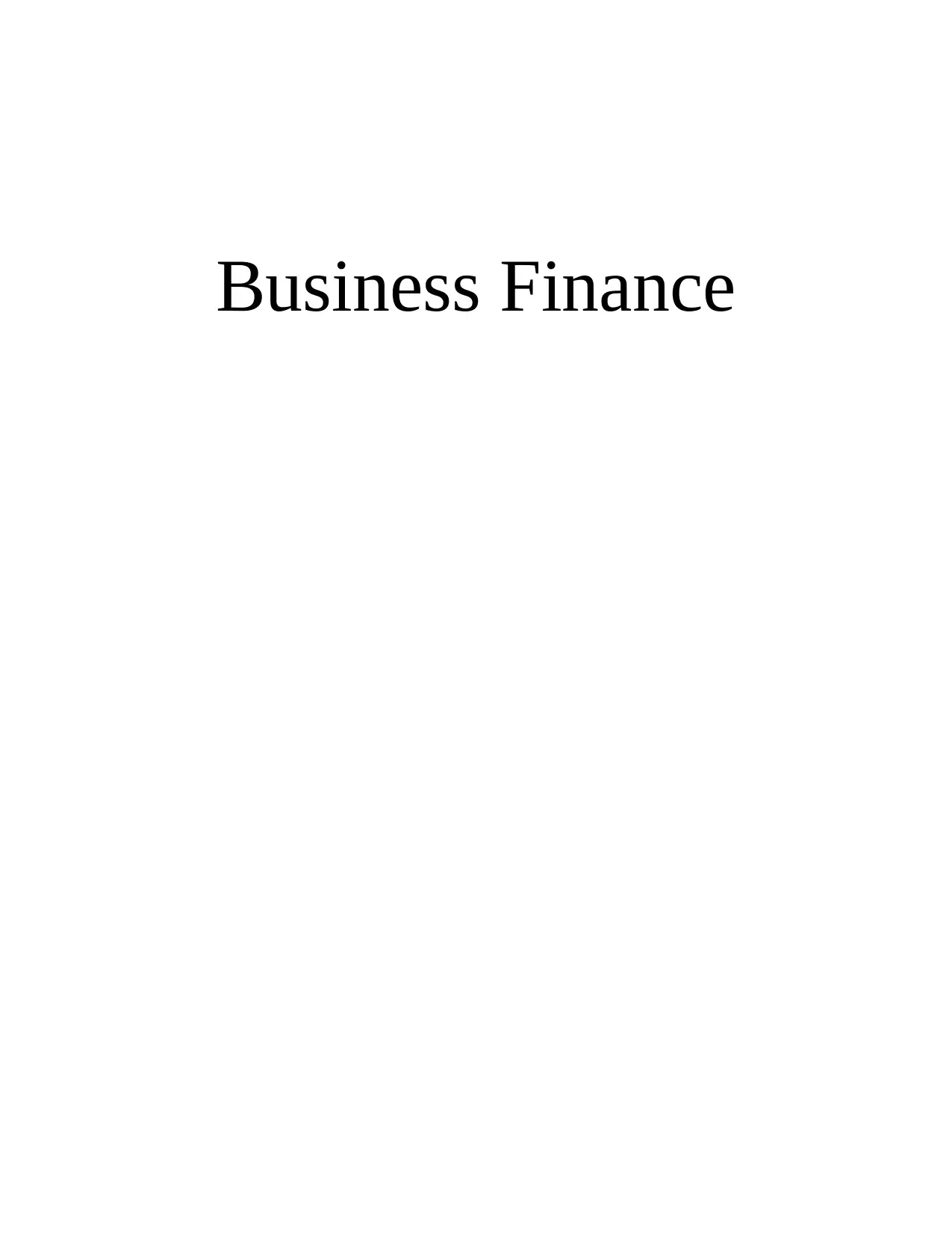
Business Finance
Paraphrase This Document
Need a fresh take? Get an instant paraphrase of this document with our AI Paraphraser

Table of Contents
EXECUTIVE SUMMARY.............................................................................................................3
TASK...............................................................................................................................................3
PART 1........................................................................................................................................3
1. Explanation about following terms:.........................................................................................3
a....................................................................................................................................................3
b....................................................................................................................................................4
2. Application of above discussed concepts in context of BrightLawns Ltd (BILL):.................4
3. Analysis and Recommendations:.............................................................................................6
PART 2........................................................................................................................................6
EXECUTIVE SUMMARY.............................................................................................................6
1....................................................................................................................................................6
2....................................................................................................................................................9
3....................................................................................................................................................9
CONCLUSION..............................................................................................................................10
REFERENCES..............................................................................................................................11
EXECUTIVE SUMMARY.............................................................................................................3
TASK...............................................................................................................................................3
PART 1........................................................................................................................................3
1. Explanation about following terms:.........................................................................................3
a....................................................................................................................................................3
b....................................................................................................................................................4
2. Application of above discussed concepts in context of BrightLawns Ltd (BILL):.................4
3. Analysis and Recommendations:.............................................................................................6
PART 2........................................................................................................................................6
EXECUTIVE SUMMARY.............................................................................................................6
1....................................................................................................................................................6
2....................................................................................................................................................9
3....................................................................................................................................................9
CONCLUSION..............................................................................................................................10
REFERENCES..............................................................................................................................11
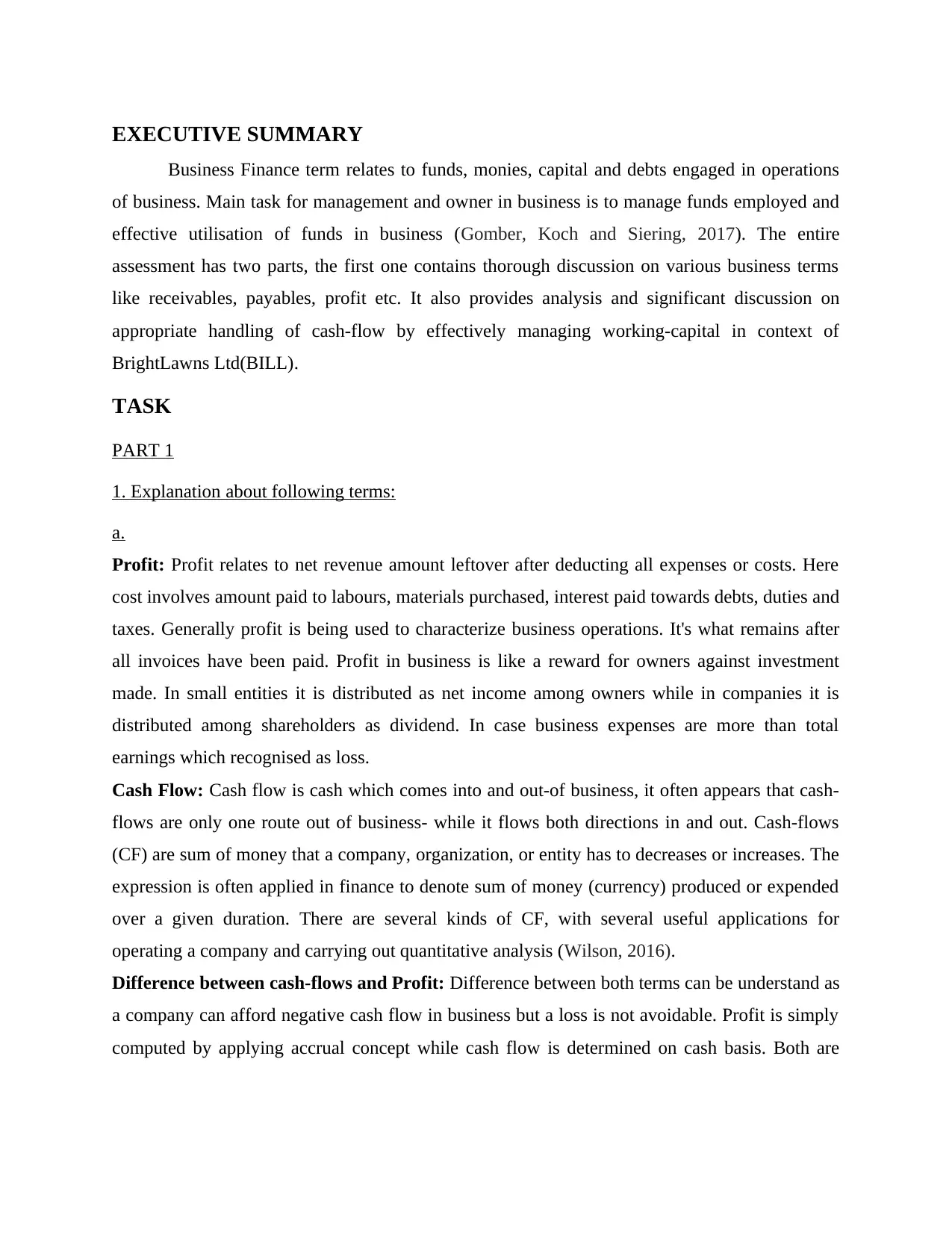
EXECUTIVE SUMMARY
Business Finance term relates to funds, monies, capital and debts engaged in operations
of business. Main task for management and owner in business is to manage funds employed and
effective utilisation of funds in business (Gomber, Koch and Siering, 2017). The entire
assessment has two parts, the first one contains thorough discussion on various business terms
like receivables, payables, profit etc. It also provides analysis and significant discussion on
appropriate handling of cash-flow by effectively managing working-capital in context of
BrightLawns Ltd(BILL).
TASK
PART 1
1. Explanation about following terms:
a.
Profit: Profit relates to net revenue amount leftover after deducting all expenses or costs. Here
cost involves amount paid to labours, materials purchased, interest paid towards debts, duties and
taxes. Generally profit is being used to characterize business operations. It's what remains after
all invoices have been paid. Profit in business is like a reward for owners against investment
made. In small entities it is distributed as net income among owners while in companies it is
distributed among shareholders as dividend. In case business expenses are more than total
earnings which recognised as loss.
Cash Flow: Cash flow is cash which comes into and out-of business, it often appears that cash-
flows are only one route out of business- while it flows both directions in and out. Cash-flows
(CF) are sum of money that a company, organization, or entity has to decreases or increases. The
expression is often applied in finance to denote sum of money (currency) produced or expended
over a given duration. There are several kinds of CF, with several useful applications for
operating a company and carrying out quantitative analysis (Wilson, 2016).
Difference between cash-flows and Profit: Difference between both terms can be understand as
a company can afford negative cash flow in business but a loss is not avoidable. Profit is simply
computed by applying accrual concept while cash flow is determined on cash basis. Both are
Business Finance term relates to funds, monies, capital and debts engaged in operations
of business. Main task for management and owner in business is to manage funds employed and
effective utilisation of funds in business (Gomber, Koch and Siering, 2017). The entire
assessment has two parts, the first one contains thorough discussion on various business terms
like receivables, payables, profit etc. It also provides analysis and significant discussion on
appropriate handling of cash-flow by effectively managing working-capital in context of
BrightLawns Ltd(BILL).
TASK
PART 1
1. Explanation about following terms:
a.
Profit: Profit relates to net revenue amount leftover after deducting all expenses or costs. Here
cost involves amount paid to labours, materials purchased, interest paid towards debts, duties and
taxes. Generally profit is being used to characterize business operations. It's what remains after
all invoices have been paid. Profit in business is like a reward for owners against investment
made. In small entities it is distributed as net income among owners while in companies it is
distributed among shareholders as dividend. In case business expenses are more than total
earnings which recognised as loss.
Cash Flow: Cash flow is cash which comes into and out-of business, it often appears that cash-
flows are only one route out of business- while it flows both directions in and out. Cash-flows
(CF) are sum of money that a company, organization, or entity has to decreases or increases. The
expression is often applied in finance to denote sum of money (currency) produced or expended
over a given duration. There are several kinds of CF, with several useful applications for
operating a company and carrying out quantitative analysis (Wilson, 2016).
Difference between cash-flows and Profit: Difference between both terms can be understand as
a company can afford negative cash flow in business but a loss is not avoidable. Profit is simply
computed by applying accrual concept while cash flow is determined on cash basis. Both are
⊘ This is a preview!⊘
Do you want full access?
Subscribe today to unlock all pages.

Trusted by 1+ million students worldwide
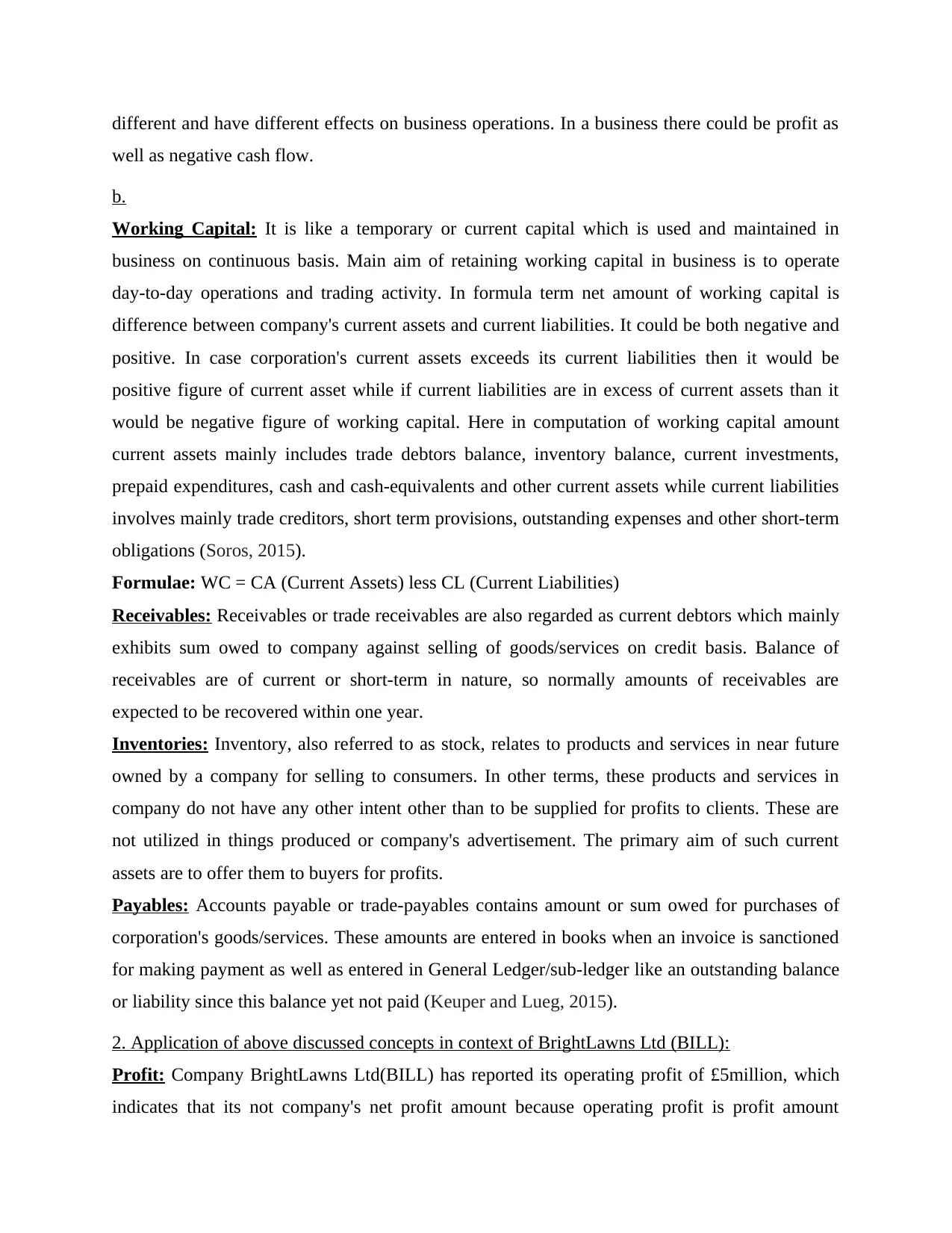
different and have different effects on business operations. In a business there could be profit as
well as negative cash flow.
b.
Working Capital: It is like a temporary or current capital which is used and maintained in
business on continuous basis. Main aim of retaining working capital in business is to operate
day-to-day operations and trading activity. In formula term net amount of working capital is
difference between company's current assets and current liabilities. It could be both negative and
positive. In case corporation's current assets exceeds its current liabilities then it would be
positive figure of current asset while if current liabilities are in excess of current assets than it
would be negative figure of working capital. Here in computation of working capital amount
current assets mainly includes trade debtors balance, inventory balance, current investments,
prepaid expenditures, cash and cash-equivalents and other current assets while current liabilities
involves mainly trade creditors, short term provisions, outstanding expenses and other short-term
obligations (Soros, 2015).
Formulae: WC = CA (Current Assets) less CL (Current Liabilities)
Receivables: Receivables or trade receivables are also regarded as current debtors which mainly
exhibits sum owed to company against selling of goods/services on credit basis. Balance of
receivables are of current or short-term in nature, so normally amounts of receivables are
expected to be recovered within one year.
Inventories: Inventory, also referred to as stock, relates to products and services in near future
owned by a company for selling to consumers. In other terms, these products and services in
company do not have any other intent other than to be supplied for profits to clients. These are
not utilized in things produced or company's advertisement. The primary aim of such current
assets are to offer them to buyers for profits.
Payables: Accounts payable or trade-payables contains amount or sum owed for purchases of
corporation's goods/services. These amounts are entered in books when an invoice is sanctioned
for making payment as well as entered in General Ledger/sub-ledger like an outstanding balance
or liability since this balance yet not paid (Keuper and Lueg, 2015).
2. Application of above discussed concepts in context of BrightLawns Ltd (BILL):
Profit: Company BrightLawns Ltd(BILL) has reported its operating profit of £5million, which
indicates that its not company's net profit amount because operating profit is profit amount
well as negative cash flow.
b.
Working Capital: It is like a temporary or current capital which is used and maintained in
business on continuous basis. Main aim of retaining working capital in business is to operate
day-to-day operations and trading activity. In formula term net amount of working capital is
difference between company's current assets and current liabilities. It could be both negative and
positive. In case corporation's current assets exceeds its current liabilities then it would be
positive figure of current asset while if current liabilities are in excess of current assets than it
would be negative figure of working capital. Here in computation of working capital amount
current assets mainly includes trade debtors balance, inventory balance, current investments,
prepaid expenditures, cash and cash-equivalents and other current assets while current liabilities
involves mainly trade creditors, short term provisions, outstanding expenses and other short-term
obligations (Soros, 2015).
Formulae: WC = CA (Current Assets) less CL (Current Liabilities)
Receivables: Receivables or trade receivables are also regarded as current debtors which mainly
exhibits sum owed to company against selling of goods/services on credit basis. Balance of
receivables are of current or short-term in nature, so normally amounts of receivables are
expected to be recovered within one year.
Inventories: Inventory, also referred to as stock, relates to products and services in near future
owned by a company for selling to consumers. In other terms, these products and services in
company do not have any other intent other than to be supplied for profits to clients. These are
not utilized in things produced or company's advertisement. The primary aim of such current
assets are to offer them to buyers for profits.
Payables: Accounts payable or trade-payables contains amount or sum owed for purchases of
corporation's goods/services. These amounts are entered in books when an invoice is sanctioned
for making payment as well as entered in General Ledger/sub-ledger like an outstanding balance
or liability since this balance yet not paid (Keuper and Lueg, 2015).
2. Application of above discussed concepts in context of BrightLawns Ltd (BILL):
Profit: Company BrightLawns Ltd(BILL) has reported its operating profit of £5million, which
indicates that its not company's net profit amount because operating profit is profit amount
Paraphrase This Document
Need a fresh take? Get an instant paraphrase of this document with our AI Paraphraser
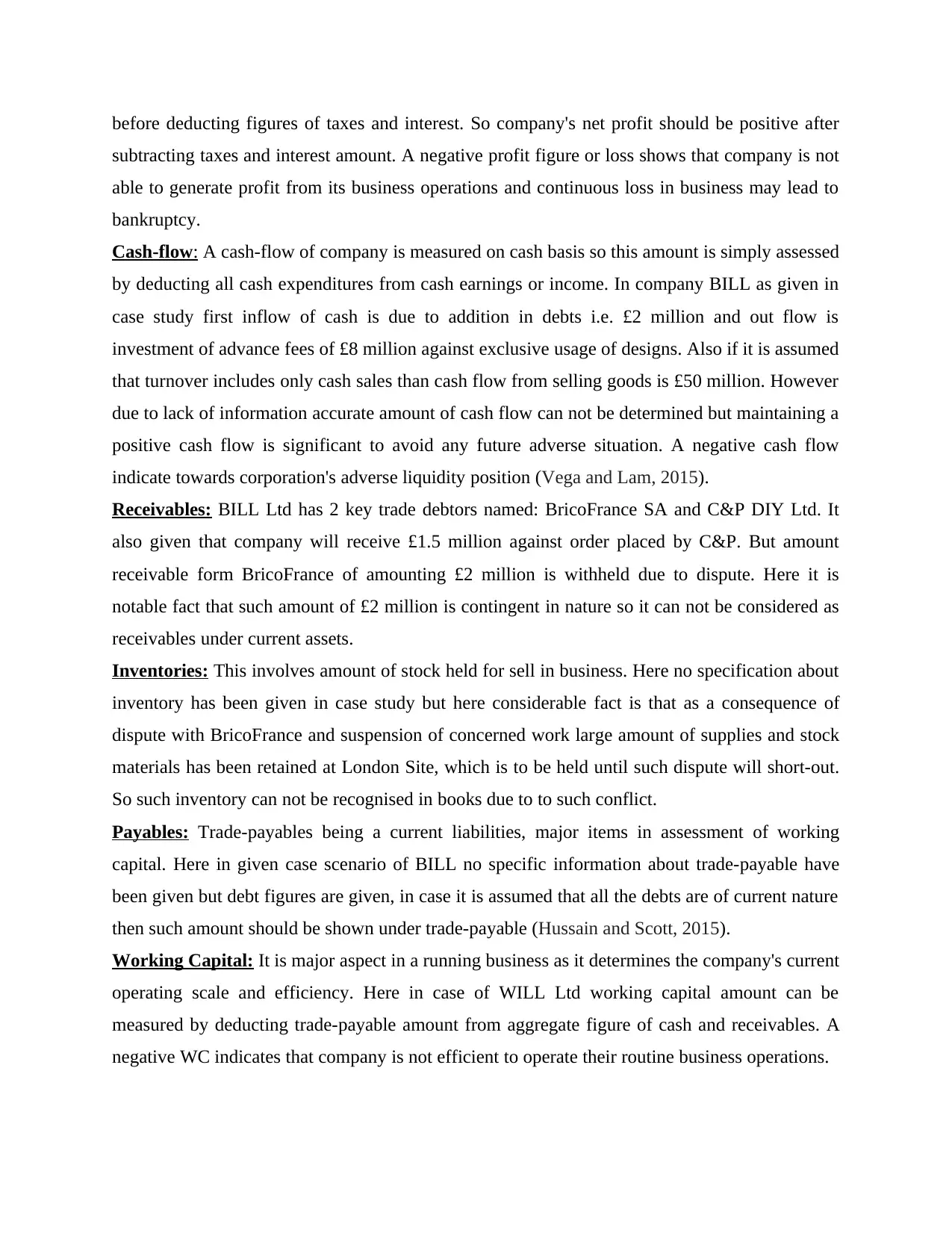
before deducting figures of taxes and interest. So company's net profit should be positive after
subtracting taxes and interest amount. A negative profit figure or loss shows that company is not
able to generate profit from its business operations and continuous loss in business may lead to
bankruptcy.
Cash-flow: A cash-flow of company is measured on cash basis so this amount is simply assessed
by deducting all cash expenditures from cash earnings or income. In company BILL as given in
case study first inflow of cash is due to addition in debts i.e. £2 million and out flow is
investment of advance fees of £8 million against exclusive usage of designs. Also if it is assumed
that turnover includes only cash sales than cash flow from selling goods is £50 million. However
due to lack of information accurate amount of cash flow can not be determined but maintaining a
positive cash flow is significant to avoid any future adverse situation. A negative cash flow
indicate towards corporation's adverse liquidity position (Vega and Lam, 2015).
Receivables: BILL Ltd has 2 key trade debtors named: BricoFrance SA and C&P DIY Ltd. It
also given that company will receive £1.5 million against order placed by C&P. But amount
receivable form BricoFrance of amounting £2 million is withheld due to dispute. Here it is
notable fact that such amount of £2 million is contingent in nature so it can not be considered as
receivables under current assets.
Inventories: This involves amount of stock held for sell in business. Here no specification about
inventory has been given in case study but here considerable fact is that as a consequence of
dispute with BricoFrance and suspension of concerned work large amount of supplies and stock
materials has been retained at London Site, which is to be held until such dispute will short-out.
So such inventory can not be recognised in books due to to such conflict.
Payables: Trade-payables being a current liabilities, major items in assessment of working
capital. Here in given case scenario of BILL no specific information about trade-payable have
been given but debt figures are given, in case it is assumed that all the debts are of current nature
then such amount should be shown under trade-payable (Hussain and Scott, 2015).
Working Capital: It is major aspect in a running business as it determines the company's current
operating scale and efficiency. Here in case of WILL Ltd working capital amount can be
measured by deducting trade-payable amount from aggregate figure of cash and receivables. A
negative WC indicates that company is not efficient to operate their routine business operations.
subtracting taxes and interest amount. A negative profit figure or loss shows that company is not
able to generate profit from its business operations and continuous loss in business may lead to
bankruptcy.
Cash-flow: A cash-flow of company is measured on cash basis so this amount is simply assessed
by deducting all cash expenditures from cash earnings or income. In company BILL as given in
case study first inflow of cash is due to addition in debts i.e. £2 million and out flow is
investment of advance fees of £8 million against exclusive usage of designs. Also if it is assumed
that turnover includes only cash sales than cash flow from selling goods is £50 million. However
due to lack of information accurate amount of cash flow can not be determined but maintaining a
positive cash flow is significant to avoid any future adverse situation. A negative cash flow
indicate towards corporation's adverse liquidity position (Vega and Lam, 2015).
Receivables: BILL Ltd has 2 key trade debtors named: BricoFrance SA and C&P DIY Ltd. It
also given that company will receive £1.5 million against order placed by C&P. But amount
receivable form BricoFrance of amounting £2 million is withheld due to dispute. Here it is
notable fact that such amount of £2 million is contingent in nature so it can not be considered as
receivables under current assets.
Inventories: This involves amount of stock held for sell in business. Here no specification about
inventory has been given in case study but here considerable fact is that as a consequence of
dispute with BricoFrance and suspension of concerned work large amount of supplies and stock
materials has been retained at London Site, which is to be held until such dispute will short-out.
So such inventory can not be recognised in books due to to such conflict.
Payables: Trade-payables being a current liabilities, major items in assessment of working
capital. Here in given case scenario of BILL no specific information about trade-payable have
been given but debt figures are given, in case it is assumed that all the debts are of current nature
then such amount should be shown under trade-payable (Hussain and Scott, 2015).
Working Capital: It is major aspect in a running business as it determines the company's current
operating scale and efficiency. Here in case of WILL Ltd working capital amount can be
measured by deducting trade-payable amount from aggregate figure of cash and receivables. A
negative WC indicates that company is not efficient to operate their routine business operations.

3. Analysis and Recommendations:
From above discussed concepts about WILL Ltd it has been analysed that company
should manage their cash-flow by effective management of company's working capital. Here in
this context following are some recommendations for WILL Ltd to manage WC and maintain
proper cash-flow in business, as follows:
1. Company should not record disputed contingent amount of to be received form
BricoFrnace under trade receivable balance. Also in case company loss the case filed
under this dispute there may be chances of payment of compensation so such contingency
should be recorded in books (Minsky, 2016).
2. Inventories i.e. supplies and raw-materials held at company's London Unit is under
dispute and can not be used in business so company should record these supplies and RM
at realisable value but not under the head of inventory as there no reasonable evidence
that such dispute will be solved within short period.
3. Company should classify their debts into current liabilities and non-current liabilities for
effective management of WC.
4. BILL company should separately classify all current liabilities and assets of its different
sites to manage the ratio of working capital in these sites. Also cash and credit sales
should be segregated for effective computation of working-capital amount.
PART 2
EXECUTIVE SUMMARY
The second part mainly emphasise on significance and use of different approaches of
budgets along with strengths and weaknesses in context of company BoatWorld. Further it
summarises appropriateness of different budgets in respective organisation as to whether
traditional approach is appropriate or alternative approach of budgeting.
1.
Purpose of framing budgets:
Budgeting is indeed an essential aspect of process of strategic planning. Budgets exhibits
fundamental elements of business along with future projections or estimates based on past
financial figures. Every company prepare different budgets as per their requirements and for
internal evaluation of business operations. Budget act as significant part of business's financial
From above discussed concepts about WILL Ltd it has been analysed that company
should manage their cash-flow by effective management of company's working capital. Here in
this context following are some recommendations for WILL Ltd to manage WC and maintain
proper cash-flow in business, as follows:
1. Company should not record disputed contingent amount of to be received form
BricoFrnace under trade receivable balance. Also in case company loss the case filed
under this dispute there may be chances of payment of compensation so such contingency
should be recorded in books (Minsky, 2016).
2. Inventories i.e. supplies and raw-materials held at company's London Unit is under
dispute and can not be used in business so company should record these supplies and RM
at realisable value but not under the head of inventory as there no reasonable evidence
that such dispute will be solved within short period.
3. Company should classify their debts into current liabilities and non-current liabilities for
effective management of WC.
4. BILL company should separately classify all current liabilities and assets of its different
sites to manage the ratio of working capital in these sites. Also cash and credit sales
should be segregated for effective computation of working-capital amount.
PART 2
EXECUTIVE SUMMARY
The second part mainly emphasise on significance and use of different approaches of
budgets along with strengths and weaknesses in context of company BoatWorld. Further it
summarises appropriateness of different budgets in respective organisation as to whether
traditional approach is appropriate or alternative approach of budgeting.
1.
Purpose of framing budgets:
Budgeting is indeed an essential aspect of process of strategic planning. Budgets exhibits
fundamental elements of business along with future projections or estimates based on past
financial figures. Every company prepare different budgets as per their requirements and for
internal evaluation of business operations. Budget act as significant part of business's financial
⊘ This is a preview!⊘
Do you want full access?
Subscribe today to unlock all pages.

Trusted by 1+ million students worldwide

planning. It provides future path of business and also points outs towards any potential issues and
financial problems. Budgeting aim to develop a significant model which shows that how
business should execute or perform efficiently. It also help to manage organisation's financial
task and events. It also assist managing officials to create a groundwork for business decision-
making (Kopnina and Blewitt, 2018). It enables actual financial performance to be assessed
against estimated operating performance. Also it allow to effectively compare organisation's
operating scale with targeted or budgets scale. Mainly 2 forms of budgeting are used in business,
as described below:
a. Traditional Budgeting:
It is core approach applied in business for framing budget for particular time-frame. It is
simply prepared by utilising prior period figures and current year expatiations based on previous
performance. It is common and easy approach not require any special assumptions. In this
approach management also apply their experiences and relevant facts as they consider necessary
to make forecast. Easiness is only advantage of heading for such a budgeting. If an organization
practices this method of budget, it is not important to reconsider that element on list (Shoup,
2017). Instead, they should actually look at past year's expenditures and then attach or
add/subtract factors like inflation, industry position, consumer preferences and demand. Budget
prepared under traditional approach save time and also easy to understand, also it offers a
effective framework for managerial tasks and promotes decentralisation. Following is kind of
traditional budget as discussed below:
Incremental Budget: The main aim of preparation of this budget is effective presentation as it
also contains current year increment in figures as in comparison with previous year figures. It is
framed applying prior period's actual/budgeted figures along with incremental figures addition to
frame new budget. Also here allocation of financial resource are also based on previous year
basis. Following are benefits and disadvantages of this form of budget, as follows:
Strengths: It is stable in nature and changes are gradual in this kind of budget. Managing
officials can easily operate different departments or units on continuous basis by applying this
budget. Preparation of this budget is very simple and also easily understandable. Provide more
clear view about financial and operating effectiveness.
financial problems. Budgeting aim to develop a significant model which shows that how
business should execute or perform efficiently. It also help to manage organisation's financial
task and events. It also assist managing officials to create a groundwork for business decision-
making (Kopnina and Blewitt, 2018). It enables actual financial performance to be assessed
against estimated operating performance. Also it allow to effectively compare organisation's
operating scale with targeted or budgets scale. Mainly 2 forms of budgeting are used in business,
as described below:
a. Traditional Budgeting:
It is core approach applied in business for framing budget for particular time-frame. It is
simply prepared by utilising prior period figures and current year expatiations based on previous
performance. It is common and easy approach not require any special assumptions. In this
approach management also apply their experiences and relevant facts as they consider necessary
to make forecast. Easiness is only advantage of heading for such a budgeting. If an organization
practices this method of budget, it is not important to reconsider that element on list (Shoup,
2017). Instead, they should actually look at past year's expenditures and then attach or
add/subtract factors like inflation, industry position, consumer preferences and demand. Budget
prepared under traditional approach save time and also easy to understand, also it offers a
effective framework for managerial tasks and promotes decentralisation. Following is kind of
traditional budget as discussed below:
Incremental Budget: The main aim of preparation of this budget is effective presentation as it
also contains current year increment in figures as in comparison with previous year figures. It is
framed applying prior period's actual/budgeted figures along with incremental figures addition to
frame new budget. Also here allocation of financial resource are also based on previous year
basis. Following are benefits and disadvantages of this form of budget, as follows:
Strengths: It is stable in nature and changes are gradual in this kind of budget. Managing
officials can easily operate different departments or units on continuous basis by applying this
budget. Preparation of this budget is very simple and also easily understandable. Provide more
clear view about financial and operating effectiveness.
Paraphrase This Document
Need a fresh take? Get an instant paraphrase of this document with our AI Paraphraser
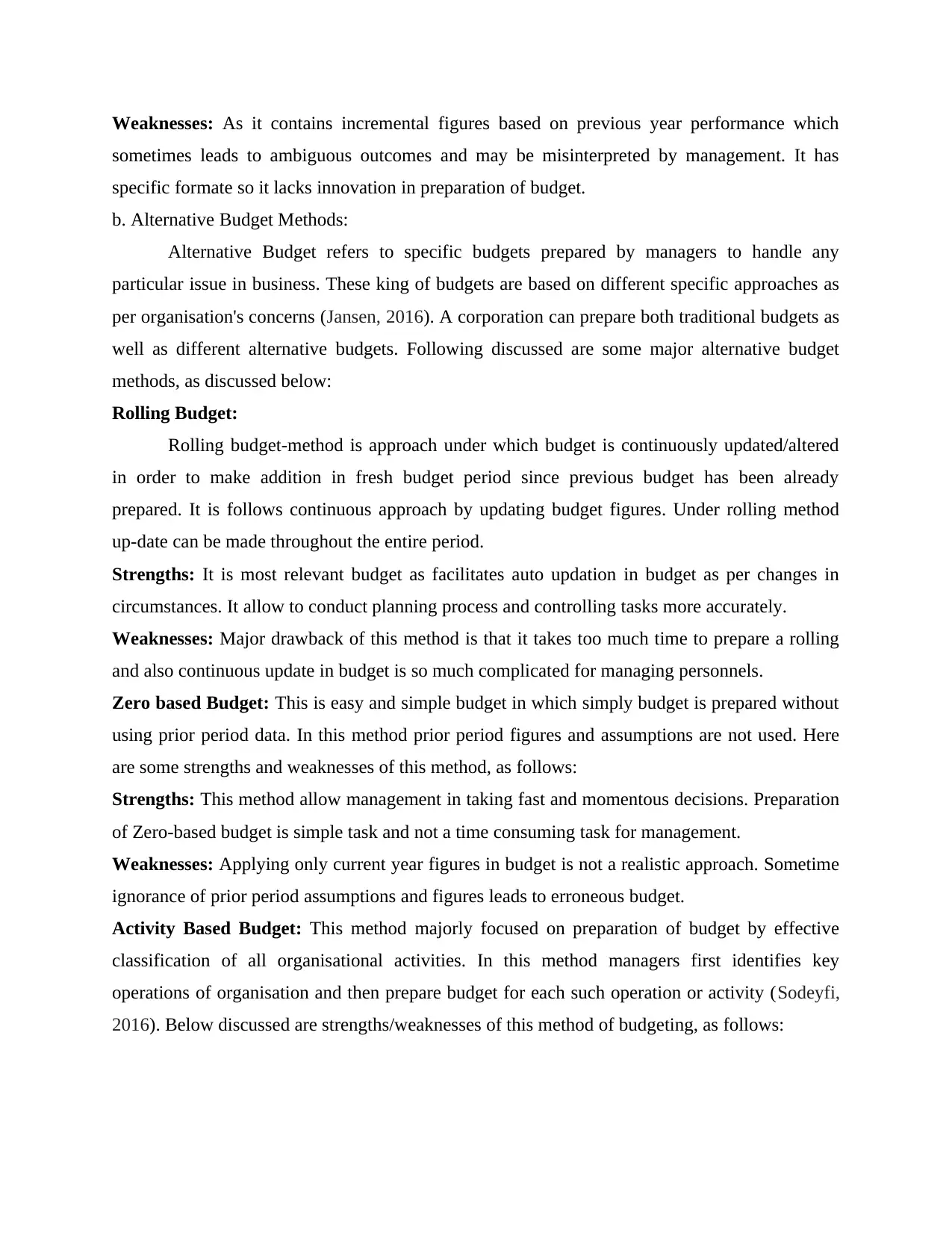
Weaknesses: As it contains incremental figures based on previous year performance which
sometimes leads to ambiguous outcomes and may be misinterpreted by management. It has
specific formate so it lacks innovation in preparation of budget.
b. Alternative Budget Methods:
Alternative Budget refers to specific budgets prepared by managers to handle any
particular issue in business. These king of budgets are based on different specific approaches as
per organisation's concerns (Jansen, 2016). A corporation can prepare both traditional budgets as
well as different alternative budgets. Following discussed are some major alternative budget
methods, as discussed below:
Rolling Budget:
Rolling budget-method is approach under which budget is continuously updated/altered
in order to make addition in fresh budget period since previous budget has been already
prepared. It is follows continuous approach by updating budget figures. Under rolling method
up-date can be made throughout the entire period.
Strengths: It is most relevant budget as facilitates auto updation in budget as per changes in
circumstances. It allow to conduct planning process and controlling tasks more accurately.
Weaknesses: Major drawback of this method is that it takes too much time to prepare a rolling
and also continuous update in budget is so much complicated for managing personnels.
Zero based Budget: This is easy and simple budget in which simply budget is prepared without
using prior period data. In this method prior period figures and assumptions are not used. Here
are some strengths and weaknesses of this method, as follows:
Strengths: This method allow management in taking fast and momentous decisions. Preparation
of Zero-based budget is simple task and not a time consuming task for management.
Weaknesses: Applying only current year figures in budget is not a realistic approach. Sometime
ignorance of prior period assumptions and figures leads to erroneous budget.
Activity Based Budget: This method majorly focused on preparation of budget by effective
classification of all organisational activities. In this method managers first identifies key
operations of organisation and then prepare budget for each such operation or activity (Sodeyfi,
2016). Below discussed are strengths/weaknesses of this method of budgeting, as follows:
sometimes leads to ambiguous outcomes and may be misinterpreted by management. It has
specific formate so it lacks innovation in preparation of budget.
b. Alternative Budget Methods:
Alternative Budget refers to specific budgets prepared by managers to handle any
particular issue in business. These king of budgets are based on different specific approaches as
per organisation's concerns (Jansen, 2016). A corporation can prepare both traditional budgets as
well as different alternative budgets. Following discussed are some major alternative budget
methods, as discussed below:
Rolling Budget:
Rolling budget-method is approach under which budget is continuously updated/altered
in order to make addition in fresh budget period since previous budget has been already
prepared. It is follows continuous approach by updating budget figures. Under rolling method
up-date can be made throughout the entire period.
Strengths: It is most relevant budget as facilitates auto updation in budget as per changes in
circumstances. It allow to conduct planning process and controlling tasks more accurately.
Weaknesses: Major drawback of this method is that it takes too much time to prepare a rolling
and also continuous update in budget is so much complicated for managing personnels.
Zero based Budget: This is easy and simple budget in which simply budget is prepared without
using prior period data. In this method prior period figures and assumptions are not used. Here
are some strengths and weaknesses of this method, as follows:
Strengths: This method allow management in taking fast and momentous decisions. Preparation
of Zero-based budget is simple task and not a time consuming task for management.
Weaknesses: Applying only current year figures in budget is not a realistic approach. Sometime
ignorance of prior period assumptions and figures leads to erroneous budget.
Activity Based Budget: This method majorly focused on preparation of budget by effective
classification of all organisational activities. In this method managers first identifies key
operations of organisation and then prepare budget for each such operation or activity (Sodeyfi,
2016). Below discussed are strengths/weaknesses of this method of budgeting, as follows:
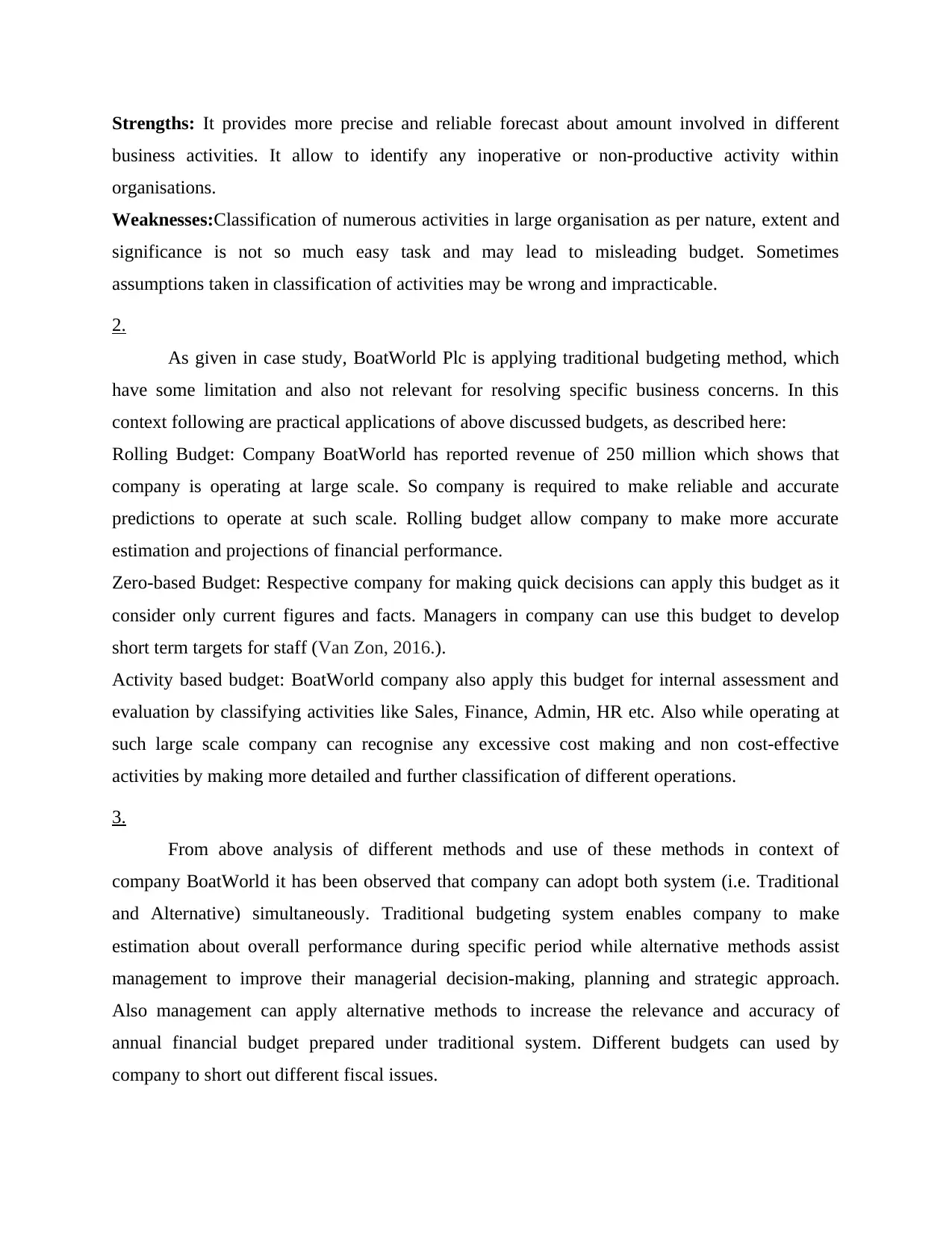
Strengths: It provides more precise and reliable forecast about amount involved in different
business activities. It allow to identify any inoperative or non-productive activity within
organisations.
Weaknesses:Classification of numerous activities in large organisation as per nature, extent and
significance is not so much easy task and may lead to misleading budget. Sometimes
assumptions taken in classification of activities may be wrong and impracticable.
2.
As given in case study, BoatWorld Plc is applying traditional budgeting method, which
have some limitation and also not relevant for resolving specific business concerns. In this
context following are practical applications of above discussed budgets, as described here:
Rolling Budget: Company BoatWorld has reported revenue of 250 million which shows that
company is operating at large scale. So company is required to make reliable and accurate
predictions to operate at such scale. Rolling budget allow company to make more accurate
estimation and projections of financial performance.
Zero-based Budget: Respective company for making quick decisions can apply this budget as it
consider only current figures and facts. Managers in company can use this budget to develop
short term targets for staff (Van Zon, 2016.).
Activity based budget: BoatWorld company also apply this budget for internal assessment and
evaluation by classifying activities like Sales, Finance, Admin, HR etc. Also while operating at
such large scale company can recognise any excessive cost making and non cost-effective
activities by making more detailed and further classification of different operations.
3.
From above analysis of different methods and use of these methods in context of
company BoatWorld it has been observed that company can adopt both system (i.e. Traditional
and Alternative) simultaneously. Traditional budgeting system enables company to make
estimation about overall performance during specific period while alternative methods assist
management to improve their managerial decision-making, planning and strategic approach.
Also management can apply alternative methods to increase the relevance and accuracy of
annual financial budget prepared under traditional system. Different budgets can used by
company to short out different fiscal issues.
business activities. It allow to identify any inoperative or non-productive activity within
organisations.
Weaknesses:Classification of numerous activities in large organisation as per nature, extent and
significance is not so much easy task and may lead to misleading budget. Sometimes
assumptions taken in classification of activities may be wrong and impracticable.
2.
As given in case study, BoatWorld Plc is applying traditional budgeting method, which
have some limitation and also not relevant for resolving specific business concerns. In this
context following are practical applications of above discussed budgets, as described here:
Rolling Budget: Company BoatWorld has reported revenue of 250 million which shows that
company is operating at large scale. So company is required to make reliable and accurate
predictions to operate at such scale. Rolling budget allow company to make more accurate
estimation and projections of financial performance.
Zero-based Budget: Respective company for making quick decisions can apply this budget as it
consider only current figures and facts. Managers in company can use this budget to develop
short term targets for staff (Van Zon, 2016.).
Activity based budget: BoatWorld company also apply this budget for internal assessment and
evaluation by classifying activities like Sales, Finance, Admin, HR etc. Also while operating at
such large scale company can recognise any excessive cost making and non cost-effective
activities by making more detailed and further classification of different operations.
3.
From above analysis of different methods and use of these methods in context of
company BoatWorld it has been observed that company can adopt both system (i.e. Traditional
and Alternative) simultaneously. Traditional budgeting system enables company to make
estimation about overall performance during specific period while alternative methods assist
management to improve their managerial decision-making, planning and strategic approach.
Also management can apply alternative methods to increase the relevance and accuracy of
annual financial budget prepared under traditional system. Different budgets can used by
company to short out different fiscal issues.
⊘ This is a preview!⊘
Do you want full access?
Subscribe today to unlock all pages.

Trusted by 1+ million students worldwide
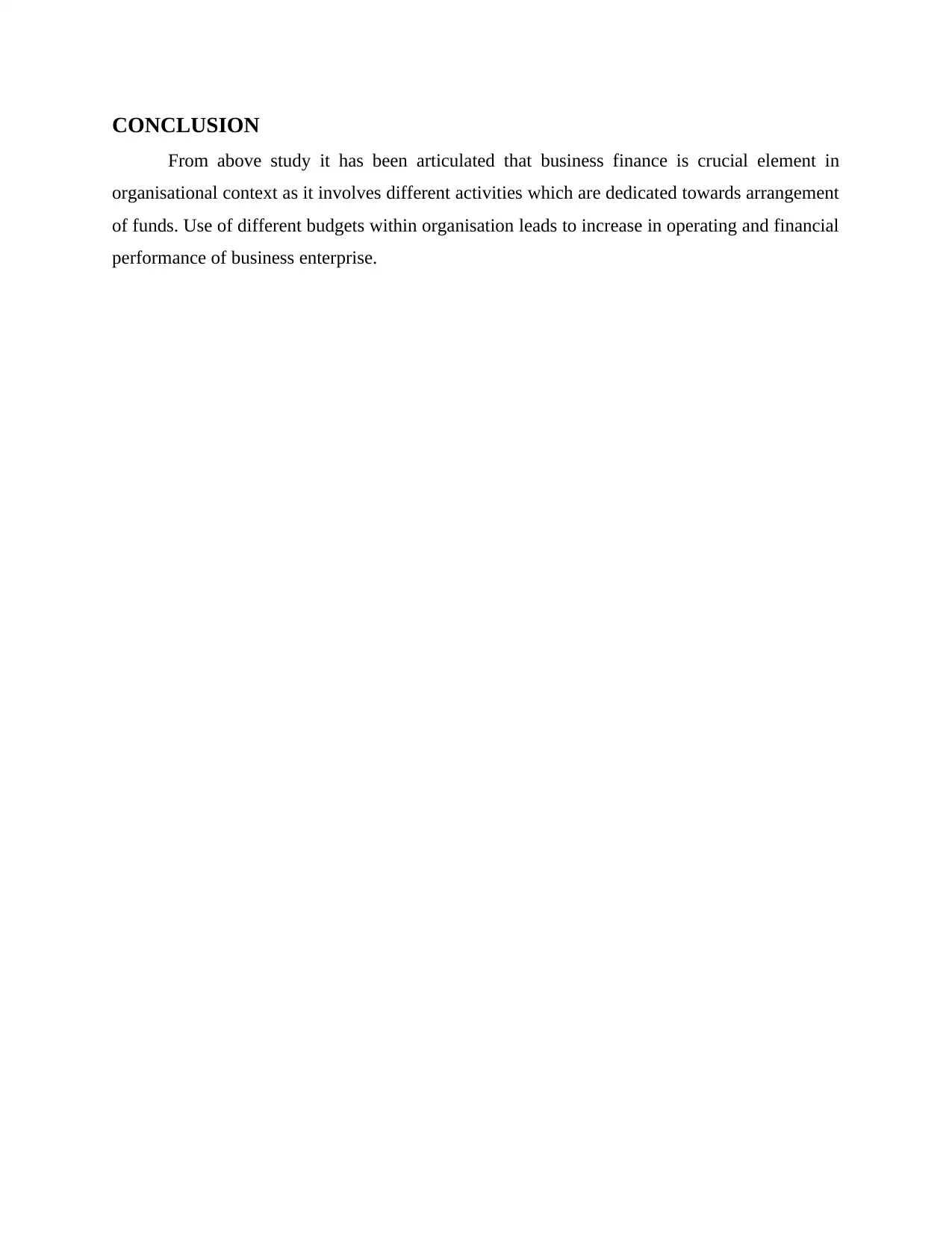
CONCLUSION
From above study it has been articulated that business finance is crucial element in
organisational context as it involves different activities which are dedicated towards arrangement
of funds. Use of different budgets within organisation leads to increase in operating and financial
performance of business enterprise.
From above study it has been articulated that business finance is crucial element in
organisational context as it involves different activities which are dedicated towards arrangement
of funds. Use of different budgets within organisation leads to increase in operating and financial
performance of business enterprise.
Paraphrase This Document
Need a fresh take? Get an instant paraphrase of this document with our AI Paraphraser
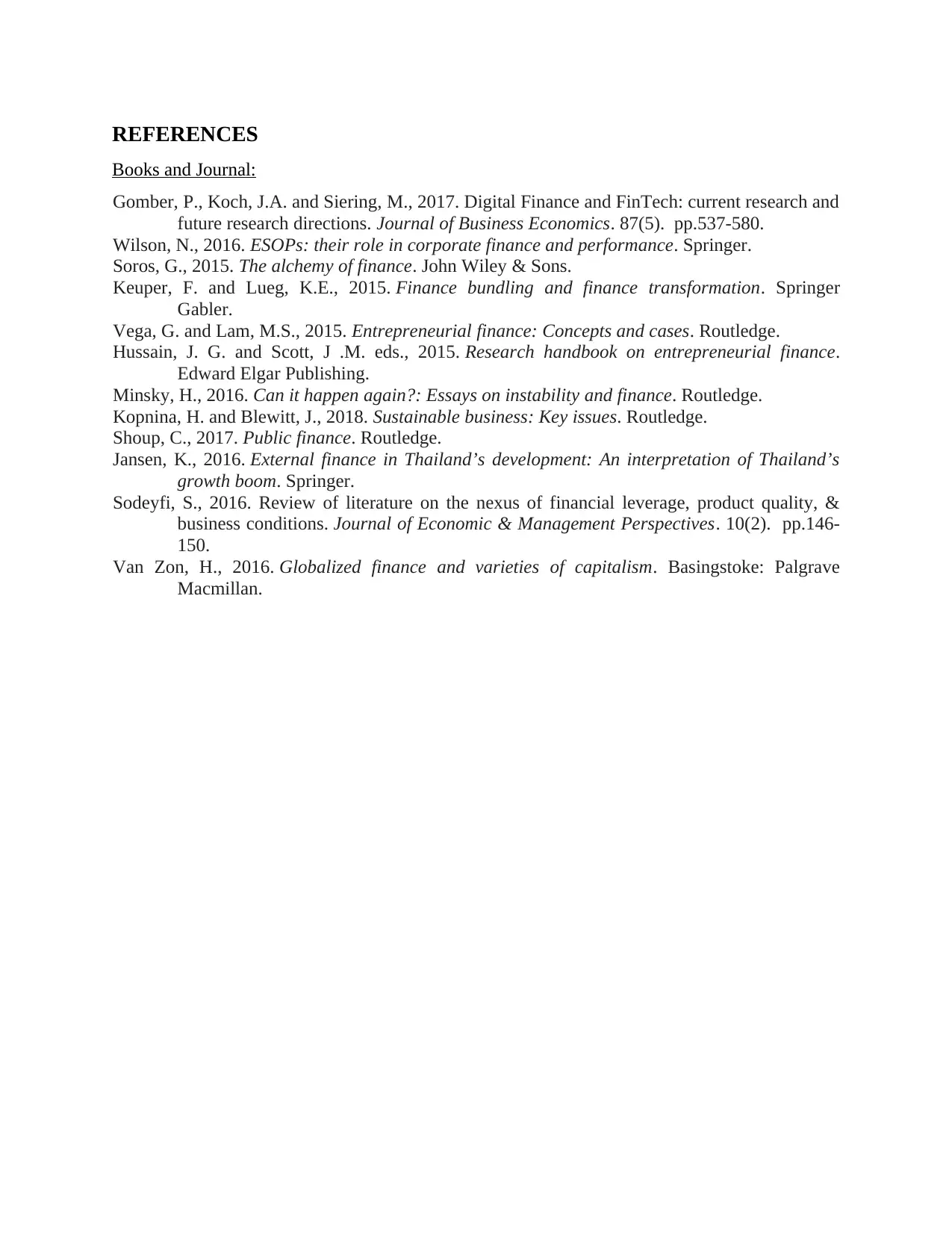
REFERENCES
Books and Journal:
Gomber, P., Koch, J.A. and Siering, M., 2017. Digital Finance and FinTech: current research and
future research directions. Journal of Business Economics. 87(5). pp.537-580.
Wilson, N., 2016. ESOPs: their role in corporate finance and performance. Springer.
Soros, G., 2015. The alchemy of finance. John Wiley & Sons.
Keuper, F. and Lueg, K.E., 2015. Finance bundling and finance transformation. Springer
Gabler.
Vega, G. and Lam, M.S., 2015. Entrepreneurial finance: Concepts and cases. Routledge.
Hussain, J. G. and Scott, J .M. eds., 2015. Research handbook on entrepreneurial finance.
Edward Elgar Publishing.
Minsky, H., 2016. Can it happen again?: Essays on instability and finance. Routledge.
Kopnina, H. and Blewitt, J., 2018. Sustainable business: Key issues. Routledge.
Shoup, C., 2017. Public finance. Routledge.
Jansen, K., 2016. External finance in Thailand’s development: An interpretation of Thailand’s
growth boom. Springer.
Sodeyfi, S., 2016. Review of literature on the nexus of financial leverage, product quality, &
business conditions. Journal of Economic & Management Perspectives. 10(2). pp.146-
150.
Van Zon, H., 2016. Globalized finance and varieties of capitalism. Basingstoke: Palgrave
Macmillan.
Books and Journal:
Gomber, P., Koch, J.A. and Siering, M., 2017. Digital Finance and FinTech: current research and
future research directions. Journal of Business Economics. 87(5). pp.537-580.
Wilson, N., 2016. ESOPs: their role in corporate finance and performance. Springer.
Soros, G., 2015. The alchemy of finance. John Wiley & Sons.
Keuper, F. and Lueg, K.E., 2015. Finance bundling and finance transformation. Springer
Gabler.
Vega, G. and Lam, M.S., 2015. Entrepreneurial finance: Concepts and cases. Routledge.
Hussain, J. G. and Scott, J .M. eds., 2015. Research handbook on entrepreneurial finance.
Edward Elgar Publishing.
Minsky, H., 2016. Can it happen again?: Essays on instability and finance. Routledge.
Kopnina, H. and Blewitt, J., 2018. Sustainable business: Key issues. Routledge.
Shoup, C., 2017. Public finance. Routledge.
Jansen, K., 2016. External finance in Thailand’s development: An interpretation of Thailand’s
growth boom. Springer.
Sodeyfi, S., 2016. Review of literature on the nexus of financial leverage, product quality, &
business conditions. Journal of Economic & Management Perspectives. 10(2). pp.146-
150.
Van Zon, H., 2016. Globalized finance and varieties of capitalism. Basingstoke: Palgrave
Macmillan.
1 out of 11
Related Documents
Your All-in-One AI-Powered Toolkit for Academic Success.
+13062052269
info@desklib.com
Available 24*7 on WhatsApp / Email
![[object Object]](/_next/static/media/star-bottom.7253800d.svg)
Unlock your academic potential
Copyright © 2020–2026 A2Z Services. All Rights Reserved. Developed and managed by ZUCOL.





